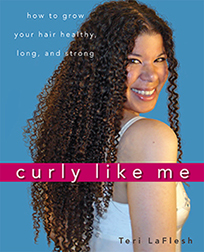
Available now!
Curly Like Me, the off-the-grid, do-it yourself owner's manual for tightly curly hair, is ready for ordering. Grab your copy today!

Every purchase made from
this site (through Amazon)
helps support it — and it
doesn't cost you anything
extra.
|
|
In the ingredient descriptions: Good means that I like to see this in a product's list of ingredients. Okay means this product appears safe for a curly person like me to use. Caution means that this ingredient may not be good in some hair care products, or for some people. Avoid means this ingredient may hurt your hair. If you see this ingredient in a hair product, it's best to put it down and walk away.
|
|
| |
Styrax benzoin
(aka Benzoin resin, Benzoin, Benzoin Gum)
Avoid
Per Wikipedia, Benzoin resin is a resin obtained from the bark of several species of Styrax trees. It's used in perfumes, some kinds of incense, as a flavoring, and even medicine (such as tincture of benzoin). Commonly (but incorrectly) called "benzoin", since benzoin is actually a chemical compound that does not contain the crystalline compound Benzoin.
Benzoin resin is a common ingredient in making incense and perfumes because it has a sweet vanilla scent, plus it is a fixative. Gum benzoin is a major ingredient in church incense.
Per Gottschalck [pg 2678], it functions as an adhesive, film former, fragrance, and skin conditioning often found in body and hand products, such as night skin creams.
See also:
Benzoin resin Balsam
Source(s):
Gottschalck https://en.wikipedia.org/wiki/Benzoin_resin
|
|
References:
Applewhite, Thomas H., ed. Proceedings of the World Conference on Lauric Oils: Sources, Processing, and Applications
AOCS Publishing, 1994.
Barel, André O., Marc Paye, and Howard I. Maibach., eds. Handbook of Cosmetic Science and Technology, Second Edition
Marcel Dekker, Inc., 2001.
Begoun, Paula. Don’t Go Shopping for Hair-Care Products Without Me. 3rd Edition.
Renton: Beginning Press, 2005.
Begoun, Paula. The Beauty Bible.
Renton: Beginning Press, 2002.
Begoun, Paula. Don’t Go to the Cosmetics Counter Without Me.
Renton: Beginning Press, 2003.
Bellum, Sarah, ed. The Beauty Brains: Real Scientists Answer Your Beauty Questions
New York: Brains Publishing, 2008.
Gottschalk, Tari E. and McEwen, Gerald N, Jr. PhD, eds. International Cosmetic Ingredient Dictionary and Handbook, Tenth Edition 2004, Volumes 1-4.
Washington D. C.: The Cosmetic, Toiletry, and Fragance Association, 2004.
Halal, John Hair Structure and Chemistry Simplified, Fifth Edition
Albany: Milady, 2002.
Hunting, Anthony L.L. Encyclopedia of Conditioning Rinse Ingredients.
Cranford, NJ: Micelle Press, Inc., 1987.
Hunting, Anthony L.L. Encyclopedia of Shampoo Ingredients.
Cranford, NJ: Micelle Press, Inc., 1983.
Johnson, Dale H. (Ed.). Hair and Hair Care, Cosmetic Science and Technology Series. Vol. 17.
New York: Marcel Dekker, 1997. Print.
Nnanna, Ifendu A. and Jiding Xia., eds. Protein-Based Surfactants: Synthesis: Physicochemical Properties, and Applications (Surfactant Science)
Madison Heights: CRC, 2001.
Quadflieg, Jutta Maria. Fundamental properties of Afro-American hair as related to their straightening/relaxing behaviour.
Diss. U of Rheinisch-Westfälischen Technischen Hochschule Aachen, 2003.
Schueller, Randy and Perry Romanowski, eds. Conditioning Agents for Hair and Skin.
New York: Marcel Dekker, Inc., 1999.
Winter, Ruth M.S. A Consumer's Dictionary of Cosmetic Ingredients: Complete Information About the Harmful and Desirable Ingredients Found in Cosmetics and Cosmeceuticals
New York: Three Rivers Press, 2005.
Zviak, Charles., ed. The Science of Hair Care (Dermatology)
New York: Marcel Dekker, Inc., 1986.
|
|